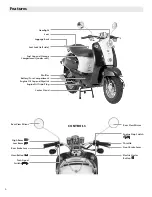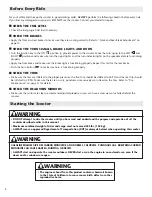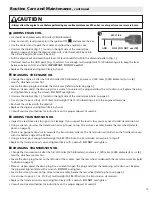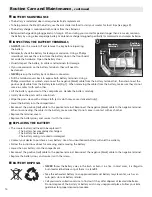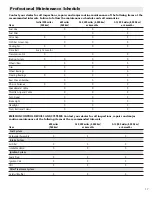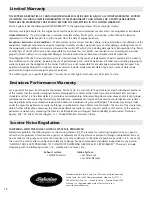
10
Riding the Scooter
ENTERING ROADWAYS
• Apply the turn signal if needed.
• Make sure there is no oncoming traffic.
ALWAYS
be aware of other vehicles on public roads. Many accidents are caused
when drivers of cars do not see scooters who share the road.
• Release the brake and gradually advance the throttle for smooth acceleration.
ACCELERATION AND DECELERATION
• Adjust speed by twisting the throttle. Twist the throttle toward you to accelerate. Twist the throttle away from you to
decelerate.
NOTE:
Your new scooter has an automatic transmission, so there is no clutch and no need to shift gears.
•
ALWAYS
allow the engine to warm up thoroughly before hard acceleration, or damage to the engine could occur.
BRAKING
PARKING
NOTE: Always park on smooth, level ground.
• Turn the ignition key to the OFF
position. Remove the key.
• Move the engine stop switch to the OFF
position.
• Dismount the scooter and engage the center stand.
•
DO NOT
park on a slope or on soft surfaces. The scooter could tip over.
•
DO NOT
park near flammable materials.
• Engage the steering lock to prevent theft (see instructions on page 6).
Breaking In the Scooter
• For the first 100 miles (160 kilometers) it is recommended that you kick start the scooter, or use the kick starter to
“prime” the engine (force fuel into the carburetor) prior to using the electric starter. This preserves battery life and
reduces wear to the electric starter during the break-in period.
•
ALWAYS
allow the engine to warm up for 2 to 3 minutes before driving.
• Do not drive the scooter at a constant speed for long periods of time during the break-in period. Avoid overheating
the engine.
WARNING
• ALWAYS apply the front and rear brakes simultaneously to slow down or come to a stop.
• BE CAUTIOUS when using the front brake. Loss of front wheel traction can make both steering and braking
ineffective. Using the front brake on loose gravel or wet road conditions can result in loss of traction.
• DO NOT continually engage the brakes for an extended period of time. This causes excessive wear and can
overheat the brakes, causing brake failure which could result in serious injury or death.
• In wet driving conditions, be aware that normal stopping distances are increased.






